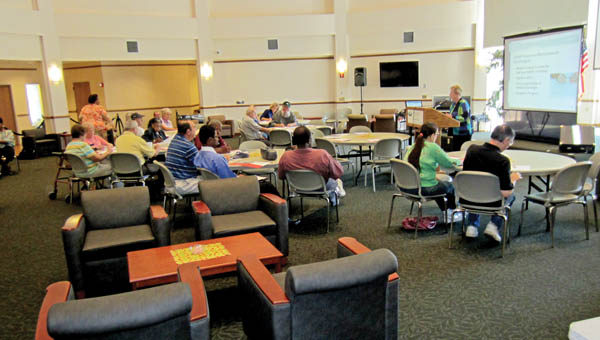Presentation helps explain legislation to residents
Published 12:00 am Sunday, September 29, 2013

AARP Ohio volunteer Ann Lemley gives a presentation about the Affordable Care Act, also known as Obamacare, in the Riffe Center Mains Rotunda at Ohio University Southern. Open enrollment for the Affordable Care Act begins Tuesday.
Open enrollment begins Tuesday for the Affordable Care Act.
As the ACA, also referred to as “Obamacare” and what many consider to be one of the landmark decisions ever by the United States Supreme Court, gets closer to taking effect, the questions and myths surrounding it have many people confused.
Several dozen people gathered in the Riffe Center Mains Rotunda on the campus of Ohio University Southern in Ironton Thursday to hear AARP Ohio volunteer Ann Lemley give a presentation about the ACA.
“Basically there are three routes available to you,” Lemley told those in attendance. “If you currently have insurance you have an option, if you do not have insurance you have an option and if you are on Medicare you have options.”
Lemley’s PowerPoint broke down the law and in simple terms explained what it entails and what it means in general.
“Under the Supreme Court’s decision, states have the right to expand Medicaid,” she said. “It ends unfair insurance practices such as an insurance company dropping a person because they get sick.”
The ACA keeps insurance companies from placing lifetime or annual limits on a person’s coverage, Lemley said, and it requires coverage for preventative and wellness services.
“Health insurance marketplaces, or exchanges, make it easier to shop for and buy health insurance,” she said. “Ohio will participate in the federal exchange.”
Another keynote measure of the ACA is the coverage extended to young adults, according to Lemley’s presentation, which allows a child or children to stay on a policy until the age of 26.
“These children can be covered even if they don’t live with you, are married or single and even after they are no longer in school,” Lemley said. “Children are also eligible if they are employed, but not offered insurance by their employer.”
Lemley’s presentation focused heavily on Medicare as well. She talked about what is changing, what stays the same and when changes will take place.
Lemley said the act improves Medicare coverage by protecting guaranteed benefits, lowering prescription drug costs and adding preventative benefits.
Lemley also discussed the “doughnut hole” associated with Medicare under the ACA.
“You fall into the doughnut hole when your out-of-pocket drug costs exceed $2,970,” she said. “You leave the hole when drug costs reach $4,740.”
The doughnut hole will gradually disappear by the year 2020 as out-of-pocket co-pays, out-of-pocket deductibles and co-insurance paid by providers accumulates.
In-depth analysis, key points of the ACA and other information are available on the Internet at www.healthlawanswers.org.





